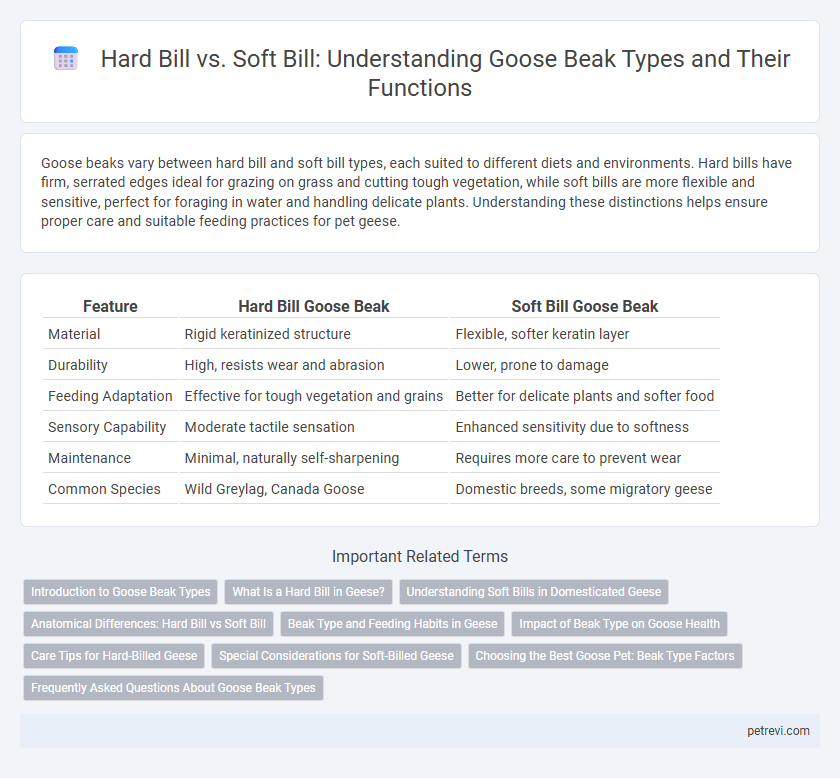Goose beaks vary between hard bill and soft bill types, each suited to different diets and environments. Hard bills have firm, serrated edges ideal for grazing on grass and cutting tough vegetation, while soft bills are more flexible and sensitive, perfect for foraging in water and handling delicate plants. Understanding these distinctions helps ensure proper care and suitable feeding practices for pet geese.
Table of Comparison
| Feature | Hard Bill Goose Beak | Soft Bill Goose Beak |
|---|---|---|
| Material | Rigid keratinized structure | Flexible, softer keratin layer |
| Durability | High, resists wear and abrasion | Lower, prone to damage |
| Feeding Adaptation | Effective for tough vegetation and grains | Better for delicate plants and softer food |
| Sensory Capability | Moderate tactile sensation | Enhanced sensitivity due to softness |
| Maintenance | Minimal, naturally self-sharpening | Requires more care to prevent wear |
| Common Species | Wild Greylag, Canada Goose | Domestic breeds, some migratory geese |
Introduction to Goose Beak Types
Goose beak types are primarily classified into hard bill and soft bill, each serving different feeding and behavioral functions. Hard bills are characterized by rigid, sharp edges ideal for grazing on tough vegetation and occasionally for defense, while soft bills have more flexible, softer edges suited for delicate foraging and manipulating softer food items. Understanding these distinctions is essential for recognizing how geese adapt to diverse habitats and dietary needs.
What Is a Hard Bill in Geese?
A hard bill in geese is characterized by a rigid, tough keratinized covering that provides durability and protection, especially useful for foraging in harsh environments. This type of bill allows geese to efficiently graze on coarse vegetation and peel tough plant materials, enhancing their ability to access diverse food sources. Compared to a soft bill, a hard bill is less flexible but offers increased resilience against wear and tear from abrasive feeding habits.
Understanding Soft Bills in Domesticated Geese
Soft bills in domesticated geese are characterized by a flexible, pliable structure that allows for gentle foraging and feeding behaviors, contrasting with the rigid, hard bills found in wild species. This adaptation supports the consumption of softer vegetation and grains common in farm environments, reducing injury and promoting efficient food intake. Understanding the differences in bill types aids in optimizing care and feeding strategies tailored to the natural behaviors and dietary needs of domesticated geese.
Anatomical Differences: Hard Bill vs Soft Bill
Goose beaks display distinct anatomical differences between hard bill and soft bill types, impacting their feeding habits and environmental adaptations. Hard bills feature a rigid, keratinized surface with serrated edges called tomia, designed for grasping and tearing tough vegetation and aquatic plants. Soft bills, on the other hand, have a more pliable, fleshy structure with fewer serrations, facilitating the consumption of softer food like seeds and small invertebrates.
Beak Type and Feeding Habits in Geese
The hard bill of geese features a firm, ridged edge ideal for grazing on tough grasses and aquatic plants, enhancing their ability to grasp and shear vegetation efficiently. In contrast, soft-billed geese possess more flexible, smoother beaks suited for dabbling and sifting through water to extract small invertebrates and softer forage. Beak morphology directly influences feeding habits, dictating diet preference and foraging behavior within different goose species.
Impact of Beak Type on Goose Health
Hard bills in geese provide increased durability and efficiency in foraging, reducing the risk of beak wear and related health issues. Soft bills, while more sensitive, allow for greater tactile feedback and precise manipulation of food, potentially improving feeding efficiency in softer vegetation habitats. The choice between hard and soft bills directly impacts feeding behavior, nutritional intake, and overall health, influencing susceptibility to injuries and diseases related to beak damage.
Care Tips for Hard-Billed Geese
Hard-billed geese require specific care to maintain the strength and health of their sturdy, chisel-shaped beaks, including providing access to abrasive materials like gravel and grit to naturally wear down the beak. Their diet should include nutrient-rich foods such as aquatic plants and insects to support beak durability and overall wellbeing. Regular inspection for cracks or overgrowth is essential to prevent feeding difficulties and infections in hard-billed geese.
Special Considerations for Soft-Billed Geese
Soft-billed geese possess a more flexible and less rigid bill structure compared to hard-billed species, requiring specialized feeding and habitat management to prevent beak damage. Their softer bills are better adapted for grazing on softer vegetation and aquatic plants, making them more sensitive to abrasive or hard food sources. Careful handling and consideration of diet texture are essential to maintaining the health and functional integrity of a soft-billed goose's beak.
Choosing the Best Goose Pet: Beak Type Factors
Choosing the best goose pet involves understanding the differences between hard bill and soft bill beak types. Hard bills are characterized by a sturdy, keratinized edge suitable for cracking tough seeds and foraging, while soft bills are more flexible and sensitive, ideal for grazing on soft vegetation and aquatic plants. Evaluating your goose's feeding habits and habitat will help determine the beak type best suited for their health and comfort.
Frequently Asked Questions About Goose Beak Types
Hard bill geese have a rigid, narrow beak ideal for grazing on tough grasses and roots, while soft bill geese possess a more flexible, broader beak suitable for dabbling in water and feeding on softer vegetation. Frequently asked questions about goose beak types often revolve around identifying differences, understanding their diet preferences, and the impact of beak structure on feeding behavior. Recognizing these distinctions aids in better habitat management and care for various goose species.
Hard Bill vs Soft Bill for Goose Beak Type Infographic

 petrevi.com
petrevi.com